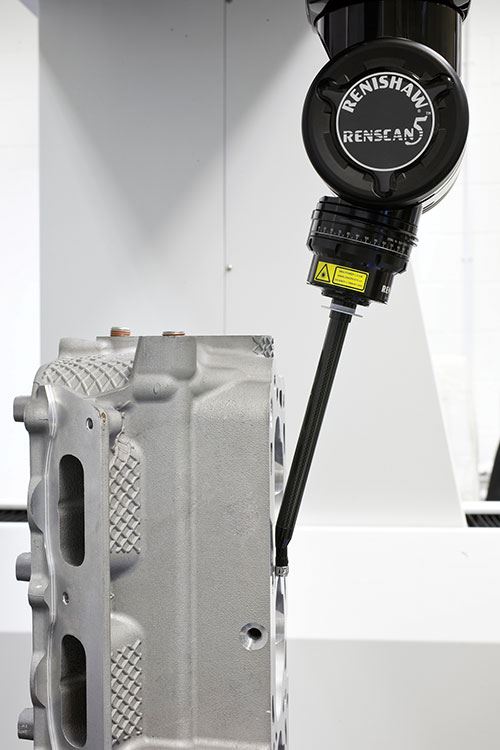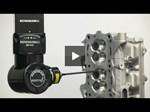Renishaw has adapted the technology behind the speed and accuracy advantages of its Revo five-axis probing system to provide CMMs with a new capability: surface finish measurement. Featuring a diamond stylus tip with a radius of 2 µm—small enough to register even the most minute imperfections—the company’s SFP1 skidded surface probe uses the Revo’s high resolution and infinite positioning capability to inspect features that have traditionally required dedicated surface finish measuring machines or hand-held devices. This limits the need to refixture parts and enables users to seamlessly incorporate both surface finish and dimensional measurement data into the same inspection report, says Brian Gow, CMM marketing manager at Renishaw. The result is improved process control and reduced labor costs and inspection lead times.
So far, this automated switching between dimensional and surface finish measurement has attracted the most interest from manufacturers serving the aerospace and automotive industries, Mr. Gow says. Aerospace OEMs increasingly require verification of ever-more-stringent surface finishes as they develop new designs to maximize engine efficiency. Meanwhile, manufacturers of cylinder blocks and other automotive components must ensure surfaces are neither too smooth nor too rough to provide the desired lubricating effect when coated with oil. Both scenarios typically involve moving parts, whether for benchtop measurement with a handheld gage or, for more demanding applications, to an expensive machine designed specifically for measuring surface finish. This can increase both lead times and the possibility of error, and it results in two different sets of inspection data for the same part.
The problem with performing these measurements on a CMM isn’t the probe itself. After all, the SFP1’s stylus doesn’t differ in any substantial way from those used on dedicated surface finish measuring machines, Mr. Gow says. Rather, the limiting factors are insufficient range of motion and insufficient resolution. The Revo measuring head alleviates both of these issues.
Originally released in 2006, the head adds A- and B-axis tilt and rotary motion to a typical CMM’s three linear axes. (The idea is to improve throughput by letting the probe itself handle small, quick movements while limiting the motion of the machine structure, which can create dynamic error when shifting at high speeds.) However, surface finish measurement requires more than five axes. That’s because unlike spherical probes used for dimensional measurement, pointed surface finish styli must be oriented perpendicular to the measured surface, Mr. Gow explains. To accommodate this requirement, the SFP1 features a passive C axis; that is, it’s not capable of independent motion. Reorienting the stylus requires clamping the probe in the tool rack, then engaging the Revo head’s rotary B axis to twist the probe into position.
Even with infinite positioning, however, surface finish measurement requires high enough precision to detect surface peaks and valleys that are measured in the 10-Nm range. Originally developed to improve accuracy on traditional CMM applications, the Revo’s laser tip-sensing technology provides sufficient resolution for surface finish measurement as well, Mr. Gow says. This system uses a laser beam that projects through the hollow stylus carrying body to a reflector mounted on a fulcrum behind the stylus tip. Touching the stylus to the part surface bends this reflector, and measuring the resulting alteration in the beam’s return path yields a precise enough result to measure surface finishes ranging from 6.3 to 0.5 Ra. The probe’s skid is held against the surface with a controlled force of approximately 0.2 N, while the stylus tip force is 0.001 N.
The SFP1 comes in both straight and cranked stylus configurations, both of which mount in the Revo’s accompanying modular rack system (MRS) for automatic toolchanging. Probe calibration is also automated: users measure a surface finish calibration artifact (SFA) mounted on the MRS rack, and the software adjusts probe parameters based on the artifact’s calibrated value. The probe outputs Ra, RMS and data formats via Renishaw’s UCCServer software, using the I++ DME protocol. The raw data can subsequently be presented to specialized surface analysis software for more detailed reporting.
Click the link under "editor's picks" at the top right-hand corner of the screen for video of the SFP1 in action.


















.png;maxWidth=300;quality=90)







